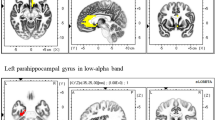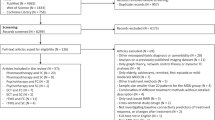Abstract
Neuroimaging studies have shown that major depressive disorder (MDD) is characterized by abnormal neural activity and connectivity. However, hemodynamic imaging techniques lack the temporal resolution needed to resolve the dynamics of brain mechanisms underlying MDD. Moreover, it is unclear whether putative abnormalities persist after remission. To address these gaps, we used microstate analysis to study resting-state brain activity in major depressive disorder (MDD). Electroencephalographic (EEG) “microstates” are canonical voltage topographies that reflect brief activations of components of resting-state brain networks. We used polarity-insensitive k-means clustering to segment resting-state high-density (128-channel) EEG data into microstates. Data from 79 healthy controls (HC), 63 individuals with MDD, and 30 individuals with remitted MDD (rMDD) were included. The groups produced similar sets of five microstates, including four widely-reported canonical microstates (A-D). The proportion of microstate D was decreased in MDD and rMDD compared to the HC group (Cohen’s d = 0.63 and 0.72, respectively) and the duration and occurrence of microstate D was reduced in the MDD group compared to the HC group (Cohen’s d = 0.43 and 0.58, respectively). Among the MDD group, proportion and duration of microstate D were negatively correlated with symptom severity (Spearman’s rho = −0.34 and −0.46, respectively). Finally, microstate transition probabilities were nonrandom and the MDD group, relative to the HC and the rMDD groups, exhibited multiple distinct transition probabilities, primarily involving microstates A and C. Our findings highlight both state and trait abnormalities in resting-state brain activity in MDD.
Similar content being viewed by others
Log in or create a free account to read this content
Gain free access to this article, as well as selected content from this journal and more on nature.com
or
References
Baxter AJ, Scott KM, Ferrari AJ, Norman RE, Vos T, Whiteford HA. Challenging the myth of an ‘epidemic’ of common mental disorders: trends in the global prevalence of anxiety and depression between 1990 and 2019. Depress Anxiety. 2014;31:506–516.
Kaiser RH, Andrews-Hanna JR, Wager TD, Pizzagalli DA. Large-scale network dysfunction in major depressive disorder a meta-analysis of resting-state functional connectivity. JAMA Psychiatry. 2015;72:603–611.
Whitton AE, Deccy S, Ironside ML, Kumar P, Beltzer M, Pizzagalli DA. EEG source functional connectivity reveals abnormal high-frequency communication among large-scale functinoal networks in depression. Biol Psychiatry Cogn Neurosci Neuroimaging. 2018;3:50–58.
Lehmann D. Brain electric microstates and cognition: the atoms of thought. In: John ER, editor. Mach. Mind, Boston: Birkhäuser; 1990. p. 209–224.
Strik WK, Lehmann D. Data-determined window size and space-oriented segmentation of spontaneous EEG map series. Electroencephalogr Clin Neurophysiol 1993;87:169–174.
Lehmann D, Michel CM. Clinical Neurophysiology EEG-defined functional microstates as basic building blocks of mental processes. Clin Neurophysiol 2011;122:1073–1074.
Michel CM, Koenig T. EEG microstates as a tool for studying the temporal dynamics of whole-brain neuronal networks: A review. Neuroimage 2018;180:577–593.
Custo A, Van De Ville D, Wells WM, Tomescu MI, Brunet D, Michel CM. Electroencephalographic resting-state networks: source localization of microstates. Brain Connect 2017;7:671–682.
Yuan H, Zotev V, Phillips R, Drevets WC, Bodurka J. Spatiotemporal dynamics of the brain at rest - Exploring EEG microstates as electrophysiological signatures of BOLD resting state networks. Neuroimage 2012;60:2062–2072.
Milz P, Pascual-Marqui RD, Achermann P, Kochi K, Faber PL. The EEG microstate topography is predominantly determined by intracortical sources in the alpha band. Neuroimage 2017;162:353–361.
Khanna A., Pascual-Leone A., Michel C. M., Farzan F. Microstates in resting-state EEG: current status and future directions. Neurosci Beiobhav Rev. 2015;49:105–113.
Strik WK, Dierks T, Becker T, Lehmann D. Larger topographical variance and decreased duration of brain electric microstates in depression. J Neural Transm 1995;99:213–222.
Al Zoubi O, Mayeli A, Tsuchiyagaito A, Misaki M, Zotev V. EEG microstates temporal dynamics differentiate individuals with mood and anxiety disorders from healthy subjects. Front Hum Neurosci 2019;13:1–10.
Damborska A, Tomescu MI, Honzirkova E, Bartecek R, Horinkova J, Fedorova S, et al. EEG resting-state large-scale brain network dynamics are related to depressive symptoms. Front Psychiatry 2019;10:548.
First MB, Spitzer RL, Gibbon M,Williams JB. Structured Clinical Interview for DSM-IV-TR Axis I disorders, research version, patient edition (pp. 94-1) (SCID-I/P) Biometric Research, New York State Psychiatric Institute, New York, NY 2002.
Beck AT, Steer RA, Brown GK. Beck Depression Inventory Manual. 2. San Antonio: The Psychological Corporation; 1996.
Murphy M, Stickgold R, Öngür D. Electroencephalogram microstate abnormalities in early-course psychosis. Biol Psychiatry Cogn Neurosci Neuroimaging. 2020;5:35–44.
Makeig S, Bell AJ, Jung T-P, Sejnowski TJ. Independent component analysis of electroencephalographic data. Adv Neural Inf Process Sys. 1996;8:145–151.
Perrin F, Pernier J, Bertrand O, Echallier JF. Spherical splines for scalp potential and current density mapping. Electroencephalogr Clin Neurophysiol 1989;72:184–187.
Murray MM, Brunet D, Michel CM. Topographic ERP analyses: a step-by-step tutorial review. Brain Topogr 2008;20:249–264.
Brunet D, Murray MM, Michel CM. Spatiotemporal analysis of multichannel EEG: CARTOOL. Comput Intell Neurosci. 2011;2011:1–15.
Michel CM, Brunet D. EEG Source Imaging: A Practical Review of the Analysis Steps. Front. Neurol. 2019;10:325. https://doi.org/10.3389/fneur.2019.00325
Charrad M, Ghazzali N, Boiteau V, Niknafs A. NbClust: An R Package for Determining the Relevant Number of Clusters in a Data Set. J Stat Softw. [Online], 61.6 2014:1–36.
Milligan GW, Cooper MC. An examination of procedures for determing the number of clusters in a data set. Psychometrika 1985;50:159–179.
Krzanowski WJ, Lai YT. A criterion for determining the number of groups in a data set using sum-of-squares clustering. Biometrics 1988;44:23–34.
Brechet L, Brunet D, Birot G, Gruetter R, Michel CM, Jorge J. Capturing the spatiotemporal dynamics of self-generated, task-initiated thoughts with EEG and fMRI. Neuroimage 2019;194:82–92.
Pascual-Marqui RD, Michel CM, Lehmann D. Segmentation of brain electrical activity into microstates; model estimation and validation. IEEE Trans Biomed Eng 1995;42:658–665.
Gärtner M, Brodbeck V, Laufs H, Schneider G. A stochastic model for EEG microstate sequence analysis. Neuroimage 2015;104:199–208.
Tadel F, Baillet S, Mosher JC, Pantazis D, Leahy RM. Brainstorm: a user-friendly application for MEG/EEG analysis. Comput Intell Neurosci 2011;2011:1–13.
Fonov V, Evans AC, Botteron K, Almli CR, Mckinstry RC, Collins DL, et al. Unbiased average age-appropriate atlases for pediatric studies. Neuroimage 2011;54:313–327.
Pascual-Marqui RD. Standardized low-resolution brain electromagnetic tomography (sLORETA): technical details. Methods Find Exp Clin Pharmacol 2002;24(Suppl D):5–12.
Koenig T, Prichep L, Lehmann D, Sosa PV, Braeker E, Kleinlogel H, et al. Millisecond by millisecond, year by year: normative EEG microstates and developmental stages. Neuroimage 2002;16:41–48.
Hughes SW, Crunelli V. Thalamic mechanisms of EEG alpha rhythms and their pathological implications. Neuroscientist 2005;11:357–372.
Britz J, Van De Ville D, Michel CM. BOLD correlates of EEG topography reveal rapid resting-state network dynamics. Neuroimage 2010;52:1162–1170.
Musso F, Brinkmeyer J, Mobascher A, Warbrick T, Winterer G. Spontaneous brain activity and EEG microstates. A novel EEG/fMRI analysis approach to explore resting-state networks. Neuroimage 2010;52:1149–1161.
Ihl R, Brinkmeyer J. Differential diagnosis of aging, dementia of the Alzheimer type and depression with EEG-segmentation. Dement Geriatr Cogn Disord 1999;10:64–69.
Atluri S, Wong W, Moreno S, Blumberger DM, Daskalakis ZJ, Farzan F. Selective modulation of brain network dynamics by seizure therapy in treatment-resistant depression. Neuroimage (Amst). 2018;20:1176–1190.
Brodbeck V, Kuhn A, von Wegner F, Morzelewski A, Tagliazucchi E, Borisov S, et al. EEG microstates of wakefulness and NREM sleep. Neuroimage 2012;62:2129–2139.
Seitzman BA, Abell M, Bartley SC, Erickson MA, Bolbecker AR, Hetrick WP. Cognitive manipulation of brain electric microstates. Neuroimage 2017;146:533–543.
Rieger K, Hernandez LD, Baenninger A, Koenig T. 15 years of microstate research in schizophrenia - Where are we? A meta-analysis. Front Psychiatry 2016;7:1–7.
Zhang Y, Yu C, Zhou Y, Li K, Li C, Jiang T. Decreased gyrification in major depressive disorder. Neuroreport 2009;20:378–380.
Zhang S, Li, C-SR. Functional connectivity mapping of the human precuneus by resting state fMRI. Neuroimage 2013;59:3548–3562.
Liao Y, Huang X, Wu Q, Yang C, Kuang W, Du M, et al. Is depression a disconnection syndrome? Meta- analysis of diffusion tensor imaging studies in patients with MDD. J Psychiatry Neurosci 2013;38:49–56.
Nugent AC, Davis RM, Zarate CA Jr, Drevets WC. Reduced thalamic volumes in major depressive disorder. Psychiatry Res 2014;213:179–185.
Seeber M, Cantonas LM, Hoevels M, Sesia T, Visser-Vandewalle V, Michel CM. Subcortical electrophysiological activity is detectable with high-density EEG source imaging. Nat Commun 2019;10:1–7.
Nunez PL and Srinivasan R. Electric fields of the brain: the neurophysics of EEG. Oxford University Press. 2006.
Author information
Authors and Affiliations
Contributions
MM: performed all analyses and drafted the first version of the paper. AEW: contributed to data analyses and interpretation, and provided revision and important intellectual content to the manuscript. SD, MLI, AR and MB: contributed to data collection and processing. MS: contributed to data interpretation, and provided revision and important intellectual content to the manuscript. DAP: designed the studies that contributed data, contributed to data interpretation, provided revision and important intellectual content to the manuscript, and provided funding. All authors approved the final version of the manuscript. MM and DAP take responsibility for the accuracy and integrity of any part of the work.
Corresponding author
Additional information
Publisher’s note Springer Nature remains neutral with regard to jurisdictional claims in published maps and institutional affiliations.
Rights and permissions
About this article
Cite this article
Murphy, M., Whitton, A.E., Deccy, S. et al. Abnormalities in electroencephalographic microstates are state and trait markers of major depressive disorder. Neuropsychopharmacol. 45, 2030–2037 (2020). https://doi.org/10.1038/s41386-020-0749-1
Received:
Revised:
Accepted:
Published:
Issue date:
DOI: https://doi.org/10.1038/s41386-020-0749-1
This article is cited by
-
Correlations between depressive symptoms, verbal working memory, and physical activity in university students: evidence based on resting EEG
BMC Psychiatry (2025)
-
Novel EEG-based diagnostic framework for Major Depressive Disorder using microstate and entropy features
Cognitive Neurodynamics (2025)
-
Unveiling Frequency-Specific Microstate Correlates of Anxiety and Depression Symptoms
Brain Topography (2025)
-
EEG microstate co-specificity in schizophrenia and obsessive–compulsive disorder
European Archives of Psychiatry and Clinical Neuroscience (2024)
-
Resting-state EEG Microstate Features Can Quantitatively Predict Autistic Traits in Typically Developing Individuals
Brain Topography (2024)



